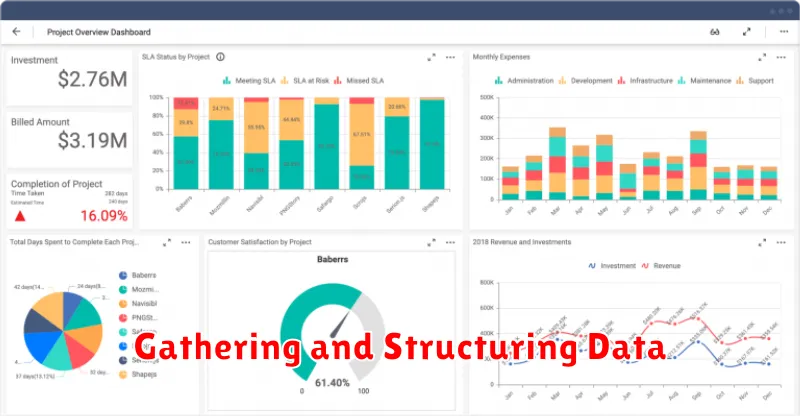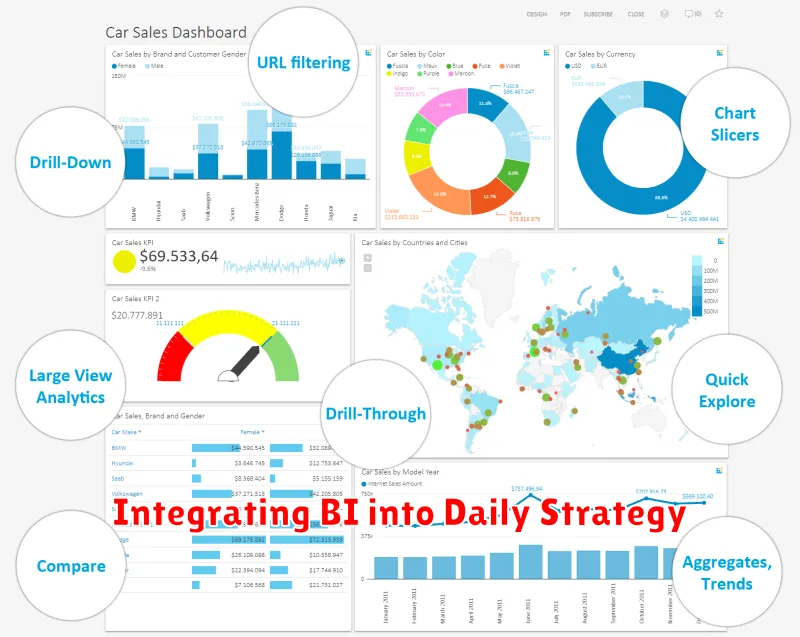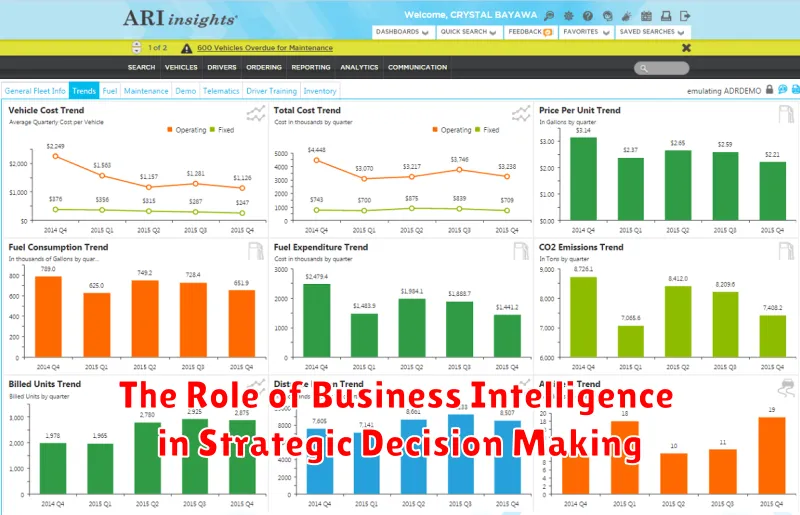In today’s rapidly evolving business landscape, data-driven decision making is no longer a luxury, but a necessity. Business intelligence (BI) plays a critical role in empowering organizations to harness the power of their data, transforming raw information into actionable insights that drive strategic decisions. By providing a comprehensive view of past performance, current trends, and future predictions, BI enables businesses to make informed choices, optimize operations, and gain a competitive edge in the marketplace. Understanding the role of business intelligence in shaping strategic decision making is essential for any organization aiming to thrive in the modern business environment.
This article explores the multifaceted ways in which business intelligence influences and enhances strategic decision making. We will delve into the core components of BI, examining how data warehousing, data mining, and reporting tools contribute to a more informed and effective decision-making process. Furthermore, we will discuss the tangible benefits that organizations can achieve by leveraging business intelligence, including improved operational efficiency, increased profitability, and enhanced strategic planning. By understanding the importance of business intelligence, businesses can unlock their full potential and navigate the complexities of the modern market with confidence.
What Is Business Intelligence (BI)?
Business intelligence (BI) is a technology-driven process for analyzing data and presenting actionable information to help executives, managers and other corporate end users make informed business decisions. BI encompasses a variety of tools, applications and methodologies that enable organizations to collect data from internal systems and external sources, prepare it for analysis, develop and run queries against that data, and create reports, dashboards and data visualizations to make the analytical results available to corporate decision makers as well as operational workers.
Key goals of BI initiatives include improving business processes, boosting operational efficiency, driving revenues and gaining competitive advantages over rivals. BI systems can also help companies identify market trends and spot business problems that need to be addressed.
BI vs Traditional Analytics
Business Intelligence (BI) and traditional analytics, while both aiming to extract insights from data, differ significantly in their approach and scope. Traditional analytics often focuses on past data, using statistical methods to explain historical trends and performance. It typically involves manual data gathering and analysis, often driven by specific queries.
BI, on the other hand, is characterized by its forward-looking approach. It leverages automated data warehousing and reporting tools to provide a holistic, real-time view of the business. BI enables proactive decision-making by identifying trends, patterns, and opportunities as they emerge. It emphasizes accessibility and self-service, empowering users across the organization to explore data and gain insights independently.
Gathering and Structuring Data

The foundation of effective business intelligence lies in the quality and organization of data. Gathering data from various sources, both internal and external, is the crucial first step. Internal sources may include sales records, customer databases, and operational data. External sources can range from market research reports to competitor analysis and social media trends.
Once gathered, data must be structured in a way that facilitates analysis. This often involves data cleaning and transformation processes to ensure consistency and accuracy. A well-structured data warehouse or data lake allows for efficient querying and reporting, providing a clear picture of business performance and trends.
Real-Time vs Historical Insights
Business intelligence leverages both real-time and historical data to inform strategic decisions. Historical data provides context, revealing long-term trends and patterns. Analyzing past performance helps identify strengths, weaknesses, and opportunities for improvement.
Real-time data, on the other hand, offers up-to-the-minute insights into current operations. This immediacy allows for quick reactions to changing market conditions, emerging threats, and sudden opportunities. Real-time data is crucial for operational decisions and tactical adjustments.
The optimal approach often involves combining both. Historical context enriches real-time data, allowing for more informed and effective decision-making. This blended perspective empowers businesses to make proactive, data-driven choices that align with long-term strategic goals while remaining adaptable to the dynamic business environment.
Visualization Tools and Dashboards
Data visualization tools play a crucial role in making complex data easily understandable. These tools transform raw data into interactive charts, graphs, and dashboards, enabling stakeholders to quickly grasp key trends and insights. Dashboards serve as a central hub, providing a comprehensive overview of key performance indicators (KPIs) and other relevant metrics.
Effective dashboards empower decision-makers to monitor performance, identify potential issues, and track progress towards strategic goals. Interactive features allow users to drill down into specific data points for a more in-depth analysis, fostering a deeper understanding of the underlying factors driving business performance.
Data-Driven Forecasting
Data-driven forecasting plays a crucial role in strategic decision-making. It leverages historical data and advanced analytical techniques to predict future trends and outcomes. This allows businesses to make more informed choices, optimize resource allocation, and mitigate potential risks.
By analyzing past performance data, businesses can identify patterns and correlations that inform future projections. These forecasts can cover various aspects of the business, including sales, demand, market trends, and financial performance.
Various statistical models and machine learning algorithms are employed in data-driven forecasting, enabling organizations to create more accurate and reliable predictions. The insights gained from these forecasts provide a strong foundation for strategic planning and tactical execution.
Improving Operational Efficiency
Business intelligence (BI) plays a crucial role in streamlining operations and boosting efficiency. By providing real-time insights into key performance indicators (KPIs), BI empowers organizations to identify bottlenecks and areas for improvement.
Data-driven decision making enables businesses to optimize processes, allocate resources effectively, and reduce operational costs. BI dashboards and reports provide a clear visualization of performance data, allowing managers to quickly identify trends and take corrective actions.
For example, BI can help optimize supply chain management by tracking inventory levels, predicting demand fluctuations, and identifying potential disruptions. This leads to reduced inventory costs, improved delivery times, and enhanced customer satisfaction.
BI for Customer Insights
Business intelligence plays a crucial role in gathering and analyzing customer data to generate actionable insights. Customer insights derived from BI tools help organizations understand customer behavior, preferences, and needs.
By analyzing data from various sources, businesses can identify key trends, segment customers effectively, and personalize their marketing efforts. This allows for more targeted campaigns and improved customer relationship management.
BI enables businesses to measure the effectiveness of marketing strategies, understand customer churn, and identify areas for improvement in customer service and product development. Ultimately, leveraging BI for customer insights can lead to increased customer satisfaction, loyalty, and profitability.
Choosing a BI Platform
Selecting the right Business Intelligence (BI) platform is crucial for maximizing its potential. Key considerations include the specific needs of your organization, the types of data you work with, and your budget.
Assess whether you need a cloud-based, on-premise, or hybrid solution. Cloud-based solutions often offer scalability and accessibility, while on-premise solutions provide greater control. Hybrid approaches combine elements of both.
Consider the platform’s features. Essential functionalities typically include data visualization, reporting, dashboards, and data mining capabilities. Advanced analytics features, like predictive modeling and machine learning, may be important depending on your analytical needs.
Integrating BI into Daily Strategy

Integrating Business Intelligence (BI) into daily strategy goes beyond simply checking dashboards. It requires a shift in organizational mindset, embedding data-driven insights into everyday operations. This means empowering teams to access and interpret relevant data, fostering a culture of data literacy.
Key areas where daily integration can yield significant impact include operational efficiency, sales performance, and customer engagement. By monitoring key performance indicators (KPIs) and identifying emerging trends, businesses can react quickly to market changes and make more informed, proactive decisions.
Consider sales performance. Daily BI integration can enable sales teams to identify underperforming products or regions, adjust sales strategies in real-time, and personalize customer interactions based on data-driven insights. Similarly, operational teams can leverage BI to optimize workflows, identify bottlenecks, and improve resource allocation.

